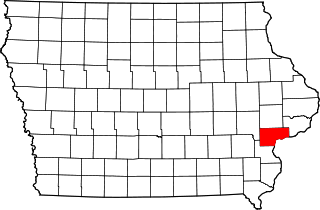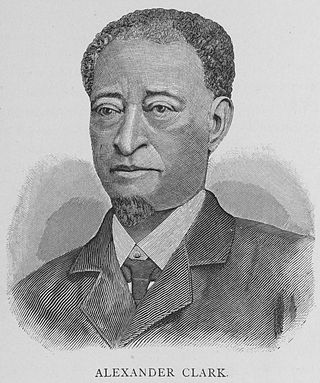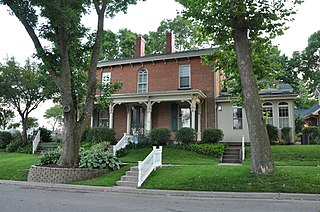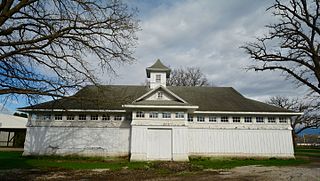
Muscatine is a city in Muscatine County, Iowa, United States. The population was 23,797 at the time of the 2020 census, an increase from 22,697 in 2000. The county seat of Muscatine County, it is located along the Mississippi River. The local business association states that the name Muscatine is not used by any other community.

This is a list of the National Register of Historic Places listings in Johnson County, Iowa.

This is a list of the National Register of Historic Places listings in Muscatine County, Iowa.

Alexander G. Clark was an African-American businessman and activist who served as United States Ambassador to Liberia in 1890–1891, where he died in office. Clark is notable for suing in 1867 to gain admission for his daughter to attend a local public school in Muscatine, Iowa. The case of Clark v. Board of School Directors achieved a constitutional ruling for integration from the Iowa Supreme Court in 1868, 86 years before the United States Supreme Court decision of Brown v. Board of Education (1954). He was a prominent leader in winning a state constitutional amendment that gained the right for African Americans in Iowa to vote (1868). Active in church, freemasonry, and the Republican Party, he became known for his speaking skills and was nicknamed "the Colored Orator of the West." He earned a law degree and became co-owner and editor of The Conservator in Chicago. His body was returned from Liberia in 1892 and buried in Muscatine, where his house has been preserved.

The Downtown Commercial Historic District in Muscatine, Iowa is a historic district that was listed on the National Register of Historic Places in 2006. At that time, it included 93 contributing buildings, one other contributing object, and 18 non-contributing buildings. The city of Muscatine was established as Bloomington in 1836. The original town was built on land that is generally flat along the Mississippi River. Residential areas were located on the surrounding hills. Commercial and industrial interests developed on the flatter land near the river. Muscatine's commercial and industrial center had developed in a 12-block area along Front Street, now Mississippi Drive, and 2nd Street between Pine Street and Mulberry Street by 1874. This area, represented by the Downtown Commercial Historic District, is the city's original commercial area. Within its boundaries is a large number of 19th-century commercial buildings, many of which were modified in the first half of the 20th century.

Hoyt Sherman Place, the home of Hoyt Sherman, was built in 1877 and is located in Des Moines, Iowa.

The Dr. Kuno Struck House, also known as Clifton Manor, is a historic building located in the West End of Davenport, Iowa, United States. It was individually listed on the National Register of Historic Places in 1984, and on the Davenport Register of Historic Properties in 1996. The house, along with its garage, became a part of the Marycrest College campus and they were both listed as contributing properties in the Marycrest College Historic District in 2004.

The Alexander Clark House is an historic house located in Muscatine, Iowa, United States. The house is associated with Alexander Clark (1826–1891), an African American civil rights pioneer and US Minister to Liberia. Clark was a 19th-century abolitionist who made his home in Muscatine for most of his adult life. He fought and won for the integration of public schools in Iowa when his daughter was forbidden to attend her neighborhood school. The case went to the Iowa Supreme Court, which resulted in the integration of all schools in the state. He was an associate of Frederick Douglass, helped to establish Iowa's only Colored regiment during the American Civil War, and the African Methodist Episcopal Church in Muscatine. Clark was named the Minister to Liberia in 1890 by President Benjamin Harrison, where he died a year later. The house was built in 1879 after a fire destroyed Clark's previous house. It was moved 200 feet (61 m) from its original location in 1975, The house was individually listed on the National Register of Historic Places in 1976. It was included as a contributing property in the West Hill Historic District in 2008.

The Lambrite–Iles–Petersen House is an historic home located in the Hamburg Historic District in Davenport, Iowa, United States. The district was added to the National Register of Historic Places in 1983. The house was individually listed on the Davenport Register of Historic Properties in 2012. This was the first residence built in the city in the Italian villa style and one of the earliest examples in the state of Iowa. The house is named for three of its early owners: Joseph Lambrite, a lumber mill owner who built the house, Dr. Thomas Iles, a physician, and John H.C. Petersen, who founded Davenport's largest department store that grew to become Von Maur.

Greenwood Cemetery Chapel is an historic building in Muscatine, Iowa, United States. It has been listed on the National Register of Historic Places since 2001.

The Clark–Blackwell House is an historic residence located in Muscatine, Iowa, United States. It has been listed on the National Register of Historic Places since 1983. The house was included as a contributing property in the West Hill Historic District in 2008.

Pliny and Adelia Fay House is a historic residence in Muscatine, Iowa, United States. It was listed on the National Register of Historic Places in 1998. The house was included as a contributing property in the West Hill Historic District in 2008.

J. C. B. Warde House is an historic residence located in Muscatine, Iowa, United States. It has been listed on the National Register of Historic Places since 1979. The house was included as a contributing property in the West Hill Historic District in 2008.

The West Hill Historic District in Muscatine, Iowa is a historic district that was listed on the National Register of Historic Places in 2008. At that time, it included 258 contributing buildings, two contributing objects, two contributing sites, and 67 non-contributing buildings. The city of Muscatine was established as Bloomington in 1836. The original town was built on land that is generally flat along the Mississippi River. Residential areas were built on the surrounding hills, while commercial and industrial interests developed on the flatter land near the river. The West Hill Historic District is immediately to the west of the Downtown Commercial Historic District. The period of significance for West Hill begins in 1839 and ends in 1958. Some of the largest and oldest historic houses in Muscatine are located here, but it also includes smaller residences of the working and middle class. By 1915, 180 of the historic houses had been built. The rest were built from 1916 to 1958. Another eight houses were built between 1960 and 1995. A majority of the houses (80%) are two stories in height. Frame construction (70%) outnumbers brick construction (30%). The architectural styles that were prominent across the country are also found here and were built at the time they were popular.

The Muscatine County Fairgrounds are located in West Liberty, Iowa, United States. It hosts the annual Muscatine County Fair. The Muscatine County Historic Preservation Commission received a grant from the State of Iowa to study the fairgrounds in 2014. Most of it was listed as a historic district on the National Register of Historic Places as the West Liberty Fairgrounds Historic District in 2015. At the time of its nomination it consisted of 42 resources, which included 16 contributing buildings, two contributing sites, two contributing structures, 16 non-contributing buildings, and six non-contributing structures. Historic tax credits will be used to rehabilitate the historic buildings on the fairgrounds.

The Oakes-Wood House, also known as the Grant Wood House, is a historic building located in Iowa City, Iowa, United States. Nicholas Oakes, who established one of the first brickyards in town, built this house in 1858. The two-story brick Italianate structure features a T-shape floor plan, low gable roof, bracketed eaves, and three brick chimneys.

The Longfellow Historic District is a nationally recognized historic district located in Iowa City, Iowa, United States. It was listed on the National Register of Historic Places in 2002. At the time of its nomination, it consisted of 355 resources, which included 250 contributing buildings, 103 non-contributing buildings, and two non-contributing structures. As the University of Iowa expanded in the early 20th-century new sections were being added to the city. The Longfellow neighborhood, named after the local elementary school completed in 1919, was part of this expansion. The northern part of the neighborhood along East Court Street developed in the 19th century because the street connected the city center to the Muscatine road. The rest of the neighborhood was platted on farm land in 1908 and 1914. A trolley line was completed to the area in 1910, leading to the creation of suburban development.

The Muscatine County Home Dairy Barn, also known as the Old Barn, is a historic building on the west side of Muscatine, Iowa, United States. The barn was built in 90 days on the county home property in 1926. It replaced other barns that had been struck by lightning and were destroyed by the resulting fire. The home was an early form of welfare system known as the poor farm. It housed indigent, homeless, or disabled people who in turn worked on the farm to cover their costs of care and food. The barn was nearly torn down in 2006 when a group of volunteers called the Friends of the Old Barn acquired and restored it. It was also in danger of being torn down in 2017 because of its lack of utilities when a nearby building which provided them to the barn was slated to be torn down. The barn is now a museum located near the Muscatine Arboretum and the Muscatine County Environmental Learning Center. It was listed on the National Register of Historic Places in 2019.

The Fair Oaks Historic District is a nationally recognized historic district located in Muscatine, Iowa, United States. It was listed on the National Register of Historic Places in 2020. At the time it was studied for the Muscatine Historic Preservation Commission it contained 231 resources, which included 176 contributing buildings and 55 non-contributing buildings. Dr. James Weed was an early settler in Muscatine. He married Mary Swift in 1847, and the couple settled a farm on the northeast side of town where they built a Gothic Revival house from 1852 to 1854. The couple donated 63 acres (25 ha) of wooded land on the east side of their property along the Mississippi River for a community park. Along the southern and western edges of their property, they plated subdivisions and eight houses had been built by the time of Mary's death in 1908. The rest of their property was opened up for development at that time and it was given the name Fair Oaks in a city-wide contest. It was divided into 101 lots. There were 57 houses in the subdivision by 1919, and 25 houses and a grocery store were built in the 1920s. Between 1930 and 1944 another 15 houses were built, 11 houses between 1945 and 1954, 13 houses between 1955 and 1965, and four houses since 1965.

Joseph E. Mills was an architect based in Detroit, Michigan. He designed the Muscatine County Courthouse in Muscatine County, Michigan, which is listed on the National Register of Historic Places. He also worked on buildings in Ionia, Michigan and on the Harrison County Courthouse in Logan, Iowa, county seat of Harrison County, Iowa.































